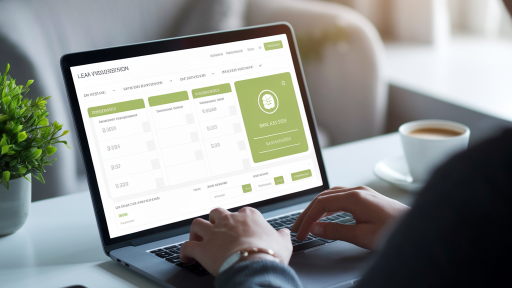In today’s fast-paced digital world, the convenience of applying for a loan from the comfort of your home is undeniable. With just a few clicks, you can access a wide array of lending options, bypassing the traditional hurdles of in-person bank visits. This accessibility has opened doors for many seeking financial flexibility.
However, this digital convenience comes with a critical responsibility: due diligence. The online lending space is vast and, unfortunately, not every player has your best interests at heart. Distinguishing between a trustworthy financial partner and a predatory scam is the most important step in your borrowing journey, safeguarding both your finances and your personal information.
Why Vetting Online Lenders is Non-Negotiable
Taking a few extra moments to thoroughly research a potential lender isn’t just a suggestion; it’s a fundamental requirement for a safe financial transaction. The consequences of choosing the wrong lender can be long-lasting and severe, while partnering with a reputable one can provide a smooth and beneficial experience.
The Risks of Choosing the Wrong Lender
Failing to properly vet an online lender can expose you to significant risks that go far beyond just a bad deal. These potential dangers can have a domino effect on your financial health.
- Predatory Interest Rates: Illegitimate lenders often target vulnerable borrowers with astronomically high Annual Percentage Rates (APRs), trapping them in a cycle of debt that is nearly impossible to escape.
- Hidden Fees and Deceptive Terms: A common tactic is to bury exorbitant fees and unfavorable clauses deep within the fine print. This can include massive origination fees, prepayment penalties, and late fees that weren’t clearly disclosed.
- Identity Theft and Data Breaches: Sharing your sensitive personal and financial information with an unsecured or fraudulent website is an open invitation for identity theft. Scammers can use your data to open other accounts or sell it on the dark web.
- Aggressive and Illegal Collection Tactics: Unscrupulous lenders may resort to harassment, threats, and other illegal practices to collect on a debt, causing immense stress and emotional harm.
The Benefits of a Reputable Partner
Conversely, finding a legitimate and ethical online lender ensures that the borrowing process works as intended—as a helpful financial tool.
-
- Fair and Transparent Terms: A reputable lender will clearly disclose all terms, including the APR, repayment schedule, and any associated fees, before you sign anything.
- Secure and Professional Process: Legitimate companies invest in robust cybersecurity to protect your data. Their websites are secure, and their application process is professional and transparent.
*
- Positive Customer Service: Should you have questions or encounter issues, a good lender will have accessible and helpful customer support to guide you.
- Regulatory Compliance: Trustworthy lenders are registered and adhere to federal and state lending laws, which are designed to protect you as a consumer.
Step-by-Step Guide to Identifying a Safe Online Lender
Navigating the online lending market requires a systematic approach. Follow these steps to significantly reduce your risk and increase your chances of finding a trustworthy financial partner.
1. Check for State Licensing and Registration
This is the most critical first step. Most legitimate lenders are required by law to be licensed to operate in each state they do business in. This registration means they are subject to regulation and oversight. Look for this information, which is typically found in the footer of the lender’s website. If you can’t find it, that’s a major red flag. Don’t just take their word for it; verify their license with your state’s attorney general’s office or department of financial regulation.
2. Verify Their Physical Address and Contact Information
A legitimate business has a physical footprint. Scrutinize the lender’s website for a verifiable physical address—not just a P.O. Box. Use a tool like Google Maps to see if the address corresponds to a real office building. Furthermore, a working phone number and professional email address should be clearly listed. Call the number to ensure you can reach a real person who can professionally answer your questions.
3. Scrutinize the Website’s Security and Professionalism
Your data’s security is paramount. Before entering any personal information, ensure the website’s URL begins with “https://” and has a padlock icon in the address bar. This indicates that the connection is encrypted and secure. Beyond that, assess the overall quality of the site. Is it well-designed, free of typos, and easy to navigate? Does it have a clear, accessible privacy policy and terms of service? A poorly constructed website often signals a less-than-professional operation.
4. Read Independent Reviews and Check Ratings
What other borrowers have experienced is a powerful indicator of a lender’s character. Look for reviews on third-party, independent sites rather than relying on the curated testimonials on the lender’s own page. Reputable sources include:
- The Better Business Bureau (BBB)
- Trustpilot
- Google Reviews
- Consumer Financial Protection Bureau (CFPB) complaint database
When reading reviews, look for patterns. A few negative reviews are normal for any business, but a consistent theme of complaints about hidden fees, terrible customer service, or aggressive collection is a clear warning sign to stay away.
Red Flags: Telltale Signs of a Loan Scam or Predatory Lender
Scammers and predatory lenders often use similar tactics designed to exploit borrowers’ urgency and anxiety. Learning to recognize these red flags is your best defense. Here is a comparison of legitimate practices versus common predatory tactics.
| Feature | Legitimate Lender Practice | Scam or Predatory Tactic |
|---|---|---|
| Credit Check | Conducts a credit check (soft or hard pull) to assess risk. Your credit history is a key factor in approval. | Advertises “Guaranteed approval!” or “No credit check loans!” to lure in borrowers with poor credit. |
| Upfront Fees | Any legitimate origination fees are disclosed upfront and typically rolled into the loan balance. | Demands an upfront fee for “insurance,” “processing,” or “application” before you receive any money. This is illegal. |
| Sense of Urgency | Provides a clear loan offer and gives you adequate time to review the terms and conditions before signing. | Uses high-pressure tactics, such as “This offer expires in one hour,” to rush you into a bad decision. |
| Communication | Uses professional communication channels, secure online portals, and a corporate email address. | Contacts you with unsolicited offers via text message, social media, or a generic email address (e.g., @gmail.com). |
Comparing Legitimate Loan Offers: What to Look For
Once you’ve identified a few potentially safe lenders, the next step is to compare their offers to find the best fit for your financial situation. Don’t just look at the loan amount; focus on the total cost of borrowing.
Understanding the Annual Percentage Rate (APR)
The APR is the single most important number to compare. It represents the total annual cost of the loan, including the interest rate and any mandatory fees, like origination fees. A loan with a lower interest rate but a high origination fee could have a higher APR than a loan with a slightly higher interest rate and no fees. Always use the APR as your primary point of comparison, as sources like Investopedia explain it’s the most accurate measure of cost.
Loan Terms and Repayment Schedule
The loan term is the length of time you have to repay the loan. This directly impacts your monthly payment and the total interest you’ll pay.
- Shorter Term: Results in higher monthly payments but less total interest paid over the life of the loan.
- Longer Term: Results in lower, more manageable monthly payments but significantly more total interest paid over time.
Choose a term that results in a monthly payment you can comfortably afford without straining your budget.
Fees and Penalties
Read the loan agreement carefully to identify all potential fees. Common ones to watch for include:
- Origination Fees: A fee for processing the loan, usually a percentage of the loan amount, deducted from the funds you receive.
- Late Fees: A penalty charged if you miss a payment due date.
- Prepayment Penalties: A fee charged if you pay off the loan early. Reputable lenders rarely charge these for personal loans.
Protecting Your Personal Information During the Application Process
Even with a legitimate lender, you must remain vigilant about protecting your data. Your personal financial information is valuable, and taking simple precautions can prevent major headaches like identity theft. Improving your awareness of how identity theft works is a key defensive measure.
Always double-check that you are on the lender’s secure, official website before entering any information. Never provide your Social Security number, bank account details, or other sensitive data over email or in response to an unsolicited phone call. Use strong, unique passwords for any online accounts you create with the lender and avoid applying for loans while connected to public, unsecured Wi-Fi networks.
Conclusion: Your Checklist for a Secure Lending Experience
The digital lending landscape offers incredible convenience, but it demands a cautious and informed approach from the borrower. By prioritizing research and being aware of the red flags, you can confidently navigate your options. Remember to verify licensing, scrutinize website security, read independent reviews, and always trust your instincts. If an offer seems too good to be true, it almost certainly is.
Taking the time to perform these checks ensures you partner with a transparent and ethical institution. Making an informed decision is the first and most crucial step toward a successful and stress-free borrowing experience. For more detailed guidance on your rights and how to avoid scams, a crucial resource is understanding the process of finding a safe and reputable online loan lender from official consumer protection agencies.




